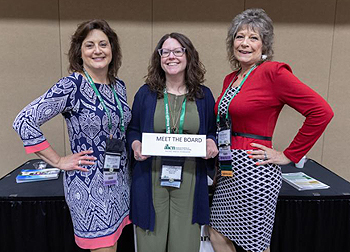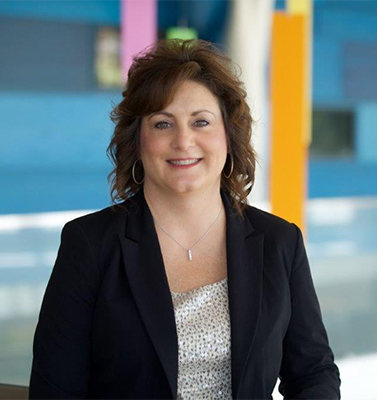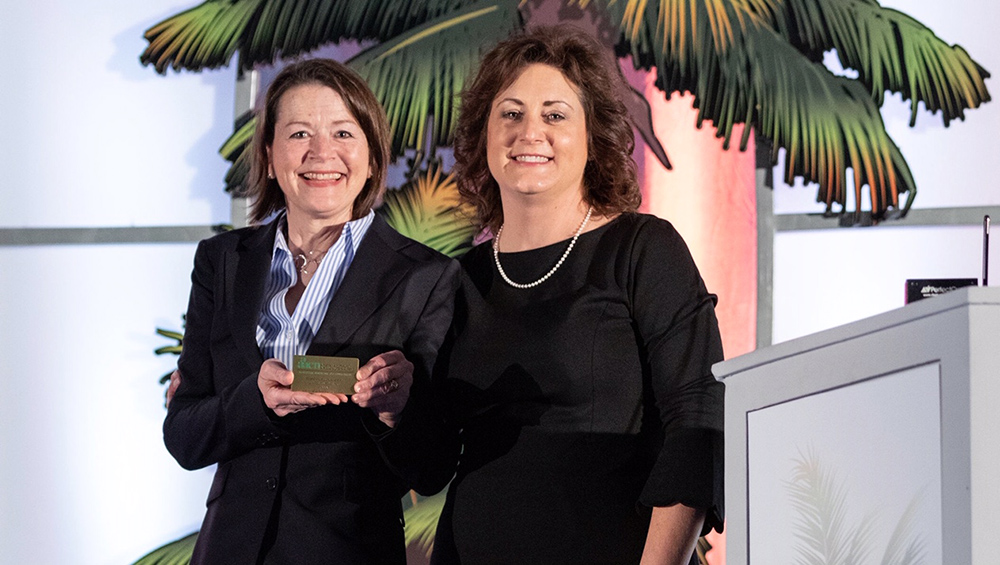Giving Nurses a Voice
|
Kris Grayem (right) gives the American Academy of Ambulatory Care Nursing (AAACN) lifetime gold membership card to outgoing President Kathy Mertens, per tradition, during the 2019 AAACN Conference closing ceremony. |
There aren’t many people who would interview for one job, then ask during the interview for a second job. And then get both. But Kris Grayem did.
She made the request in 2011 when she was interviewing for a quality job at Children’s Hospital Medical Center of Akron. She wanted the second position – an ambulatory care director role – not for her own advancement, but because she knew the ambulatory care nurses there needed a voice and a leader who understood their needs.
One could say that those reasons are why she was elected AAACN president.
Please meet Kristene K. Grayem, MSN, CNS, PPCNP-BC, RN-BC. Kris stepped into her role as AAACN president at the May 2019 AAACN Conference. She’ll serve a 1-year term, working closely with AAACN’s Board of Directors, volunteer leaders, and national office staff to fulfill the association's strategic goals and serve members. Kris will also continue her work at Akron Children’s Hospital as Vice President of Population Health.
You’ll be able to see from the interview below, we’re in good hands.
Tell us about your career. Why did you choose nursing?
I chose nursing because I wanted a career with lots of variety and flexibility. At 21 years old, I knew I’d be working a long time, and could not see myself doing the same thing day after day. I wanted flexibility so I could have a family and contribute to the world outside my workplace.
You started in pediatrics. Why?
I love children!
My mother had a daycare business when I was growing up and I began helping her there at a very young age. There’s nothing like making a difference in a child’s life.
One of my favorite quotes is by Forest Witcraft: “A hundred years from now it will not matter what my bank account was, the sort of house I lived in, or the kind of car I drove. But the world may be different because I was important in the life of a child.”
Can you describe a patient story you'll never forget and how it affected you?
This patient was not doing well and the parents made the decision to withdraw life support, but chose not to be at the bedside when we removed the child from the ventilator. I was a very young nurse and really struggled to understand how the parents could not be with the child when he passed. The parents came and said their goodbyes to the baby.
After they left, we removed the ventilator. I held, rocked and sang to him until he passed. I then performed postmortem care and dressed him. I created a memory box for the parents; I took pictures and made hand and footprints in case the family wanted to see them later. This situation really taught me the value of the relationships nurses have with patients and families.
As you know, Americans consistently rank nurses as the professionals they trust the most. This experience helped me realize what an honor and gift it is for families to trust us with their loved ones’ lives.
Do you have a moment in your early career that changed your path?
I would say that I have had many moments, and the one above is just an example of the many lessons I learned early on. I think all great nurses are constantly learning from their patients, families, the literature, and their colleagues.
Your career is so impressive. When you were a child, were you solving problems and leading others on the playground? You clearly excel at inspiring people and finding solutions.

Grayem at the 2019 AAACN Conference with AAACN CEO
Linda Alexander (center) and Past President Liz Greenberg
experiences in AAACN.
I think as a child, I may have been leading others around, but I’m pretty sure when you’re a child doing that, you’re just perceived as bossy. My two younger siblings might still describe me that way. All kidding aside, my favorite aspect of my job is helping people be the best they can be.
I love coaching and mentoring young nurses and professionals. I recently changed administrative assistants and my new hire said, “Who are all these people who want to meet with you, and do you have to meet with them?” I let her know that meeting with them is the fun part of my job!
You were the first ambulatory care nursing director at Akron Children’s Hospital. How did that happen?
The ambulatory care nurses there did not really have a nursing voice before I took the role. I had been an ambulatory care nurse in our institution and I knew firsthand the frustrations of not having a nursing leader.
I got the director position by applying for a quality role and saying that I would do the quality work if I could also have the ambulatory care nursing leadership piece.
Interestingly, they already had someone in mind for the director position, so it was a bit risky to apply for one role and then ask in the interview to change it. But it worked!
What motivates you?
Making a difference and helping others! I love my job, the institution that I work for, and the organization that I’m leading. I always say that if I won the lottery I would still work because I love the work that I do that much.
You’re a high-level executive and now a president. How do you handle stress?
I’m a perfectionist, so it can be tough at times. When things really get out of control I go back to what grounds me: My faith. No matter how much I try to be in control, I know that there is a bigger plan for me and I’m not the one directing my fate.
Your friend and mentor Judy Dawson-Jones introduced you to AAACN. What did you think of your first conference in 2011?
Once I saw myself as an ambulatory care nurse, in addition to a pediatric nurse and a nurse practitioner, the conference was incredible. As a PNP, I had always attended pediatric or nurse practitioner-specific conferences. I had never thought about attending a broader, ambulatory care-based conference.
So, the 2011 AAACN Conference was eye-opening for me! I felt I had found a new professional home. It was as if everyone at the conference understood the ambulatory care-specific challenges I was facing in my organization as a new ambulatory care nurse leader, whether they worked in a pediatric setting or not. I left feeling energized and excited.
What inspired you to become a AAACN leader?
I wanted to have a role in advancing ambulatory care nursing and I wanted to give a small piece back to the organization that has given me so much.
How has your involvement with AAACN changed your career? Changed you personally?
AAACN has helped me develop my leadership skills, pushed me outside my comfort zone, and helped build my confidence, which has allowed me to continue propelling myself forward personally and professionally.
Why do you think AAACN is so successful?
I can identify three main reasons for AAACN’s success. First and foremost, we have dedicated and talented volunteer leaders. We would not have been able to reach this point without them.
The second factor is the foundation that previous AAACN leaders have laid for the organization. We've had a host of people with great vision and leadership skills. It is these forward-thinking and very insightful individuals who have laid a rock-solid foundation for the organization.
The third major factor is the overall shift in health care from inpatient to ambulatory care settings.
As I said, ambulatory care revenue has increased, and this is truly transferring the focus to ambulatory care settings. As leaders are looking for resources to help them address ambulatory care challenges, AAACN is there with the tools and resources they need.
I have to add, my favorite aspect of AAACN is our warm and welcoming environment. I know others agree.
What are your primary goals during your year as president?
The top goal for the Board of Directors (BOD) is to advance the art and science of ambulatory care nursing by continuing to build partnerships with other disciplines and organizations.
What do you think are the main challenges ahead for AAACN? For ambulatory care nursing? For the nursing profession?
There are many current challenges for ambulatory care nursing, but what pops to mind immediately is timing. We need to be in the right place at the right time with the right care models for our patients and families.
As volumes shift from the inpatient to the ambulatory care setting, our needs in ambulatory nursing care continue to evolve. As payment models continue to transform, our needs will continue to change.
While most of us have one foot in each canoe (one foot in fee-for-service and one foot in value-based care), we need two different models of care in place. We must be ready for the new challenges we will face in the ever-evolving ambulatory care environment.
I say this because, if you look at ambulatory care nursing over the past 10 years, there have been too many changes in our profession to count.
We have to be adaptable, open, and receptive to change, and at times, we must even anticipate the changes that will be coming. We must also be creative in order to meet the needs of our patients, families, providers, and employers.
We also need to be astute about the financial challenges/constraints, so we'll be poised to make the right changes at the right times. If we're too far ahead of the curve, the transformations we make will not be accepted. If we are too far behind, we will also falter.
 A perfect example of this is care coordination and transition management (CCTM). While the evidence clearly supports the CCTM model, not everyone has bought in to the resources needed to implement the standard.
A perfect example of this is care coordination and transition management (CCTM). While the evidence clearly supports the CCTM model, not everyone has bought in to the resources needed to implement the standard.
While some nurses are moving to get certified (the credential is CCCTM®), many schools of nursing are not teaching the concepts and many institutions are not yet supporting the role.
Let’s talk more about CCTM. AAACN was on the forefront of providing resources and defining this role. Why do you think CCTM is so important today? Why is it a priority for AAACN?
With the advances in ambulatory care, we now handle many more complex cases. Add to that, patients and families have a more complicated system to navigate. This can be a burden for them!
The ambulatory care RN is the ideal health care provider to fill the gap because we spend more time with patients than any other provider and we know how to work with interdisciplinary teams. We have the knowledge, skills and attitudes to efficiently and effectively manage the care transitions and coordinate the care.
AAACN recognized the evolution in the system early on, so we acted quickly to define the CCTM role and offer resources to improve care. Patients can’t be expected to figure out the maze of health care today, especially when it comes to transitions, and certainly not if they have many comorbidities and take many medications.
I think it’s important to convey to ambulatory care nurses that CCTM offers them opportunities to work to their full potential. CCTM allows them to be an integral part of the care team and lead the coordination of the care being provided. It’s a hugely important role.
Recognizing this, AAACN is the perfect organization to lead CCTM because we are the ambulatory care nursing experts. We understand the needs of families and patients. AAACN is fully committed to further advancing the role and building on the work of the 41 thought leaders who attended AAACN’s 2018 CCTM Invitational Summit.
What would you tell a newly graduated nurse who was floundering in a career direction?
I told my recently graduated son exactly what I told my daughter when she graduated from high school 2 years ago: “Choose a career you love and you'll never work a day in your life.”
For a new nurse I would say the same thing and ask, “Why did you choose nursing? Go back to your passion and you will find your place!”
Reported by Janet D’Alesandro, AAACN Communications and Media Director.
June 2019

